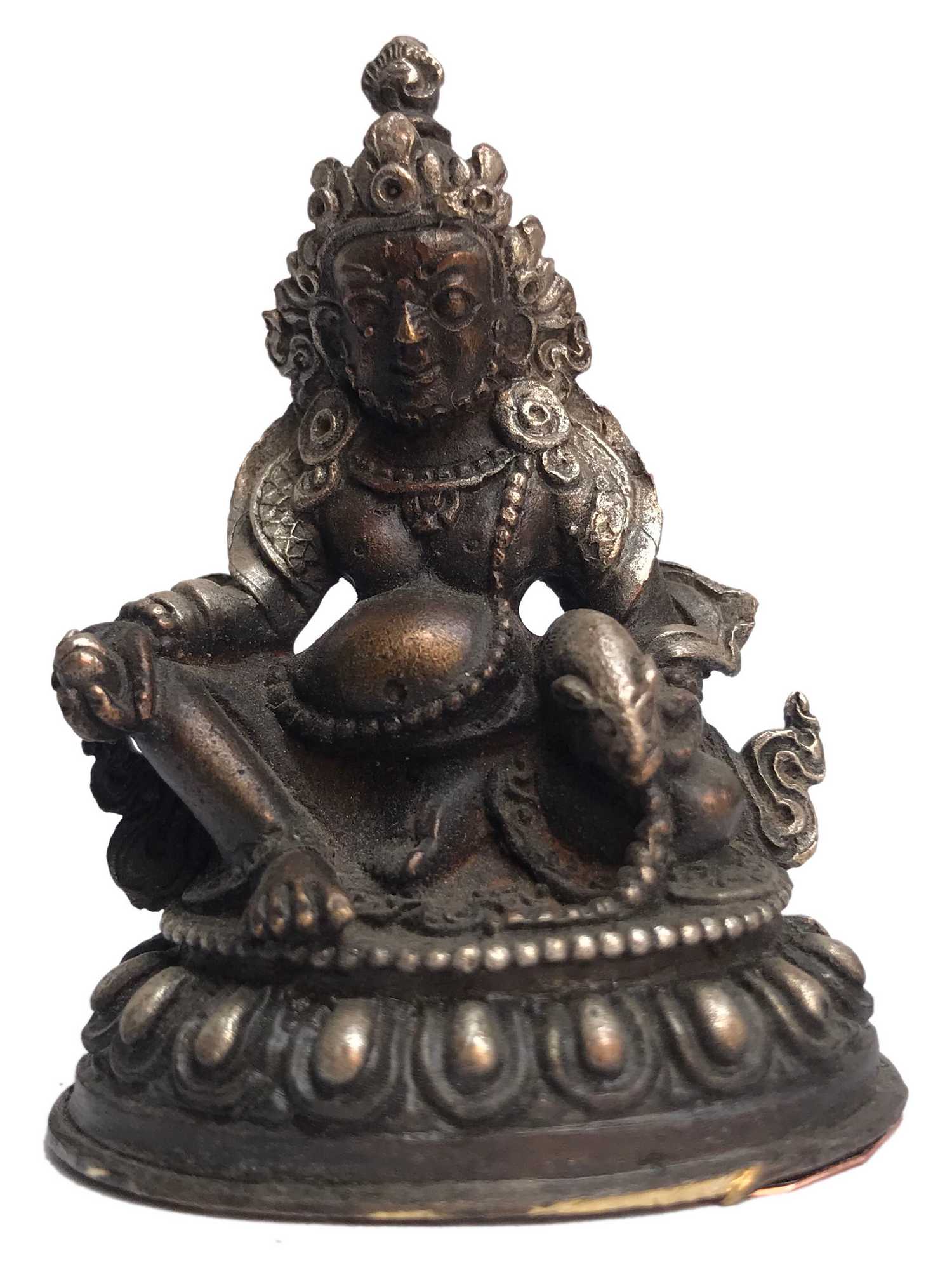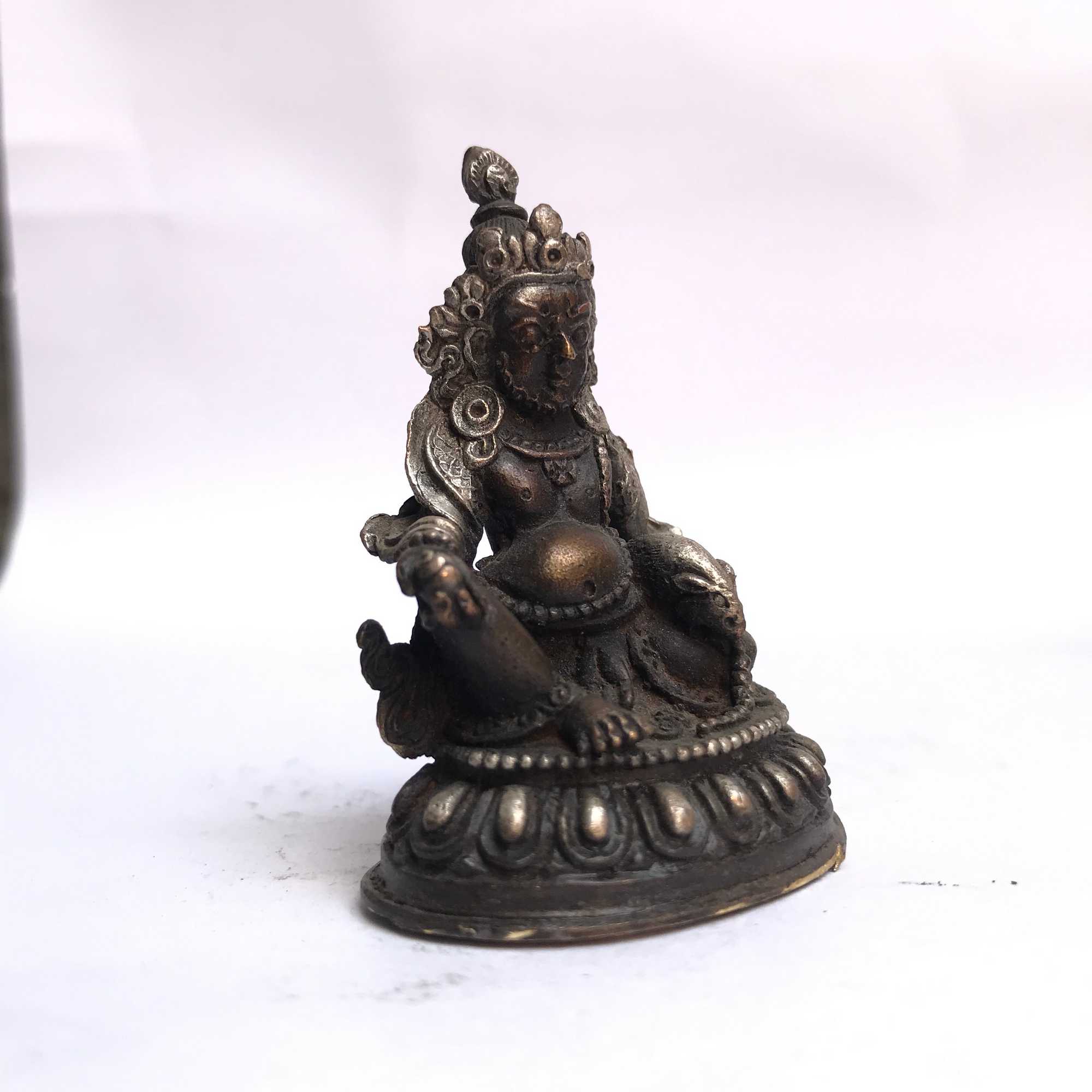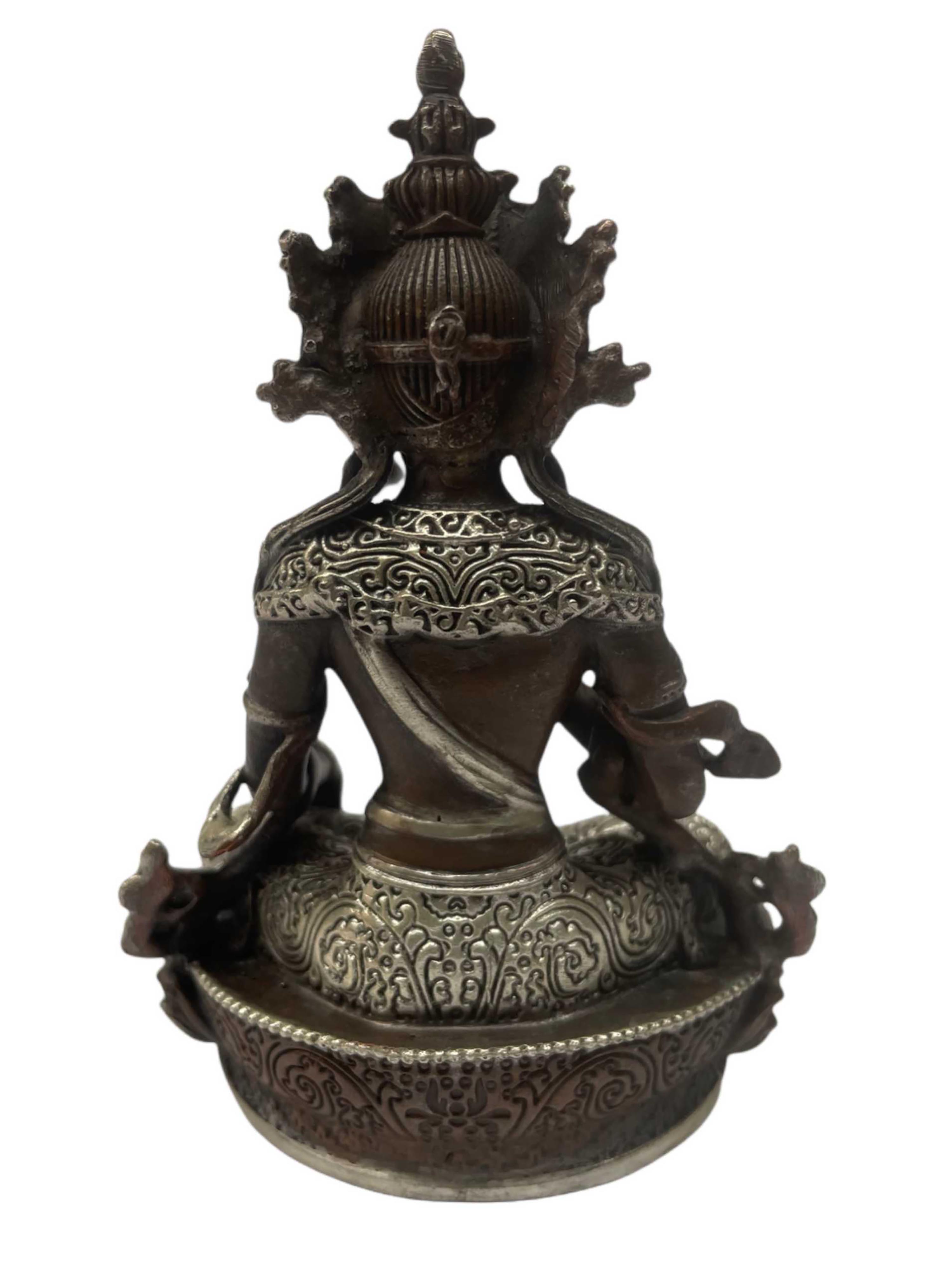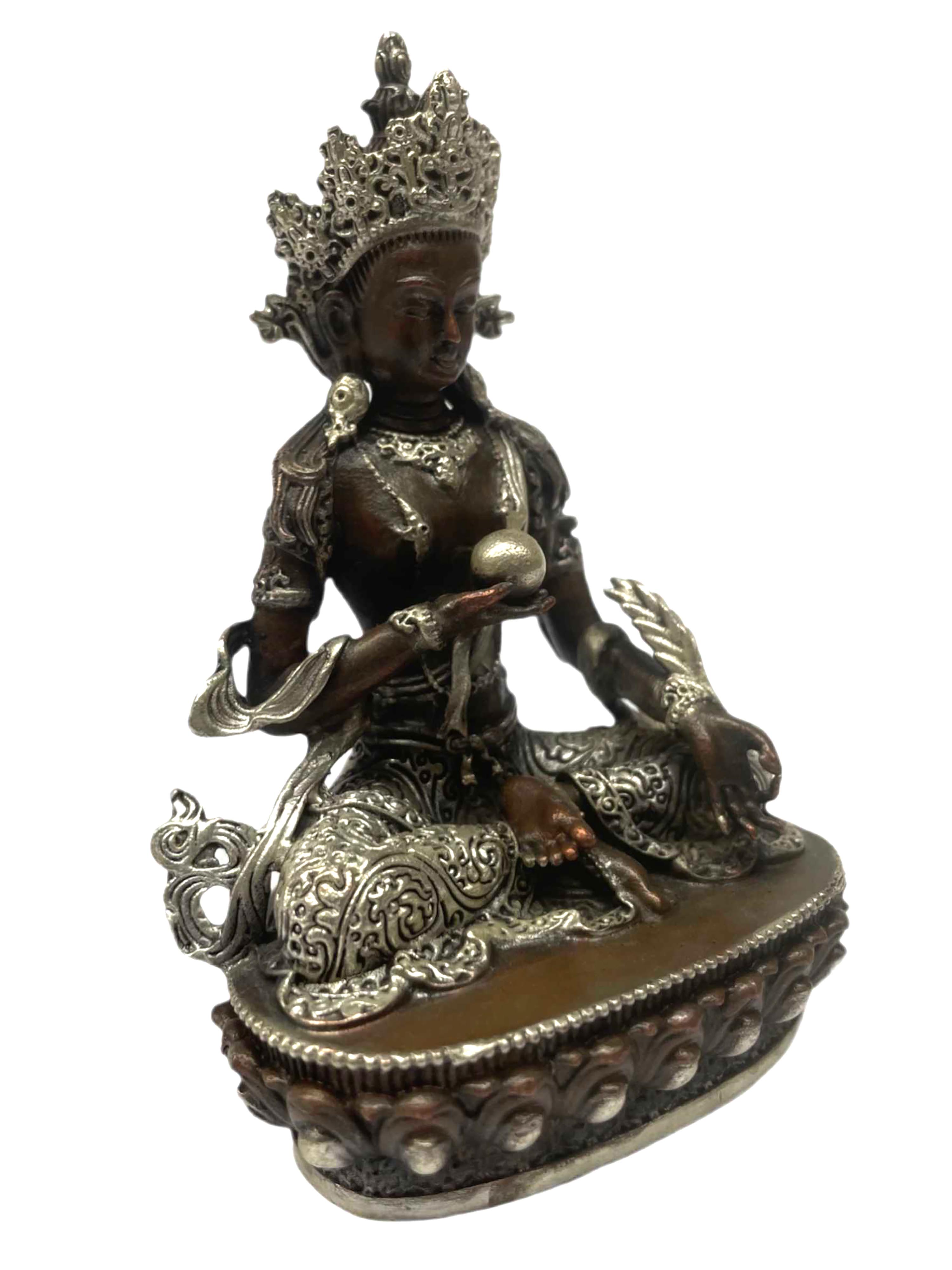Code
HCS27074
Weight
311 gm / 0.69 lbs
Size
Height
10cm (4") Width
8cm (3") Depth
4cm (2") Material
Copper
Availability
Available

Safe Payment
We accept Paypal, Money Transfer, Bank Transfer
Confidence
Protection covers your purchase and personal data.
Worldwide Delivery
We ship Worldwide, except Russia.Shipping cost US$25.2 for upto 0.5 kgs

Hotline
Talk to help line for your question on 9841267335Silver and Chocolate Oxidized
The Buddhist Statue Of Guhyasamaja, [silver And Chocolate Oxidized] features a captivating combination of partly silver plating and dark oxidation. This unique finishing technique combines the lustrous shine of silver with the rich, deep tones achieved through oxidation. In the process of creating this finish, selected areas of the Buddhist Statue Of Guhyasamaja, [silver And Chocolate Oxidized] are expertly silver-plated, creating a radiant and reflective surface that catches the light. The remaining areas are intentionally oxidized, resulting in a darkened patina that adds depth and character to the piece. Read More . . .
The Buddhist Statue Of Guhyasamaja, [silver And Chocolate Oxidized] features a captivating combination of partly silver plating and dark oxidation. This unique finishing technique combines the lustrous shine of silver with the rich, deep tones achieved through oxidation. In the process of creating this finish, selected areas of the Buddhist Statue Of Guhyasamaja, [silver And Chocolate Oxidized] are expertly silver-plated, creating a radiant and reflective surface that catches the light. The remaining areas are intentionally oxidized, resulting in a darkened patina that adds depth and character to the piece. Read More . . .
Ceramic Molding System
The Buddhist Statue Of Guhyasamaja, [silver And Chocolate Oxidized] has been crafted using the Ceramic mold casting process, a modern approach that provides an alternative to traditional methods such as the lost-wax system or rubber molding. Also referred to as ceramic molding, this technique involves the creation of a ceramic mold to cast the statue. The process begins by making a precise and detailed wax model of the desired sculpture. The wax model is then coated with layers of ceramic material, creating a sturdy mold. Once the mold is complete, it is fired in a kiln, causing the wax to melt and escape, leaving behind a cavity that perfectly replicates the original sculpture. Molten metal is then poured into the mold, allowing it to fill the cavity and take on the desired form. Once cooled and solidified, the ceramic mold is carefully broken away, revealing the final metal statue. Read More . . .
The Buddhist Statue Of Guhyasamaja, [silver And Chocolate Oxidized] has been crafted using the Ceramic mold casting process, a modern approach that provides an alternative to traditional methods such as the lost-wax system or rubber molding. Also referred to as ceramic molding, this technique involves the creation of a ceramic mold to cast the statue. The process begins by making a precise and detailed wax model of the desired sculpture. The wax model is then coated with layers of ceramic material, creating a sturdy mold. Once the mold is complete, it is fired in a kiln, causing the wax to melt and escape, leaving behind a cavity that perfectly replicates the original sculpture. Molten metal is then poured into the mold, allowing it to fill the cavity and take on the desired form. Once cooled and solidified, the ceramic mold is carefully broken away, revealing the final metal statue. Read More . . .
Iconography :
Guhyasamāja is one of the most interesting, complicated and important figures in vajrayana buddhism. It combines various important tathagata Buddhas, (Dhayani Buddhas) into one sclupture. It is perdominantly is call Akshobhayavajara which is the form of Akshobhaya buddha. Guhyasamāja is blue-black in color, a form of Akshobhya, one of the five transcendent lords. Akshobhyavajra holds a vajra and bell (ghanta) in his first two hands, and other hands hold the symbols of the four other transcendent lords, wheel of Vairocana and lotus of Amitabha in his rights, and gem of Ratnasambhava and sword of Amoghasiddhi in his lefts.
Origin of Guhaysamajha. :It is said that Guhyasamāja Tantra was taught for the first time by the Shakyamuni Buddha himsself in the form of Vajradhara to Indrabhuti the King of Oddiyana
As with most Tantras, there are different traditions and transmissions. Perhaps the oldest surviving lineage is the Jñānapada Tradition , which goes late 8th century. The most important historically is the Noble Tradition which is based on commentaries attributed to Nāgārjuna, Āryadeva and Candrakīrti.
About Guhaysamaja Tantra :As with most Tantras, there are different traditions and transmissions. Perhaps the oldest surviving lineage is the Jñānapada Tradition , which goes late 8th century. The most important historically is the Noble Tradition which is based on commentaries attributed to Nāgārjuna, Āryadeva and Candrakīrti.
The Guhyasamāja Tantra (Sanskrit; Scripture of the Esoteric Community) is one of the most important scriptures of esoteric Buddhism. In its fullest form, it consists of seventeen chapters, though a separate "explanatory tantra" known as the Appendix Tantra (uttaratantra) is sometimes considered to be its eighteenth chapter. Many scholars believe that the original core of the work consisted of the first twelve chapters, with chapters thirteen to seventeen being added later as explanatory material.
In India, it was classified as a Yoga or Mahāyoga Tantra. In Tibet it is considered an Unexcelled Yoga Tantra (rnal 'byor bla med rgyud). It develops traditions found in earlier scriptures such as the Sarva-tathāgata-tattva-saṃgraha but is focused to a greater extent on the antinomian aspects characteristic of the later Buddhist Tantras. It survives in Sanskrit manuscripts and in Tibetan and Chinese translation.
In India, it was classified as a Yoga or Mahāyoga Tantra. In Tibet it is considered an Unexcelled Yoga Tantra (rnal 'byor bla med rgyud). It develops traditions found in earlier scriptures such as the Sarva-tathāgata-tattva-saṃgraha but is focused to a greater extent on the antinomian aspects characteristic of the later Buddhist Tantras. It survives in Sanskrit manuscripts and in Tibetan and Chinese translation.
Mantra of Guhyasamaja
OM AH VAJRA DHRIK HUM HUM PHAT


![Buddhist Statue Of Guhyasamaja, [silver And Chocolate Oxidized]](https://handicraftseller.com/uploads/pics/product/thumb/2022/11/27074_4.jpg)
![Buddhist Statue Of Guhyasamaja, [silver And Chocolate Oxidized]](https://handicraftseller.com/uploads/pics/product/thumb/2022/11/27074_5.jpg)
![Buddhist Statue Of Guhyasamaja, [silver And Chocolate Oxidized]](https://handicraftseller.com/uploads/pics/product/thumb/2022/11/27074_6.jpg)
![Buddhist Statue Of Guhyasamaja, [silver And Chocolate Oxidized]](https://handicraftseller.com/uploads/pics/product/thumb/2022/11/27074_7.jpg)
![Buddhist Statue Of Guhyasamaja, [silver And Chocolate Oxidized]](https://handicraftseller.com/uploads/pics/product/thumb/2022/11/27074_8.jpg)
![Buddhist Statue Of Guhyasamaja, [silver And Chocolate Oxidized]](https://handicraftseller.com/uploads/pics/product/thumb/2022/11/27074.jpg)
![Buddhist Statue Of Guhyasamaja, [silver And Chocolate Oxidized]](https://handicraftseller.com/uploads/pics/product/thumb/2022/11/27074_0.jpg)
![Buddhist Statue Of Guhyasamaja, [silver And Chocolate Oxidized]](https://handicraftseller.com/uploads/pics/product/thumb/2022/11/27074_1.jpg)
![Buddhist Statue Of Guhyasamaja, [silver And Chocolate Oxidized]](https://handicraftseller.com/uploads/pics/product/thumb/2022/11/27074_2.jpg)
![Buddhist Statue Of Guhyasamaja, [silver And Chocolate Oxidized]](https://handicraftseller.com/uploads/pics/product/thumb/2022/11/27074_3.jpg)

 Yamantaka, Buddhist Handmade Statue,
Yamantaka, Buddhist Handmade Statue,  Yamantaka, Buddhist Handmade Statue,
Yamantaka, Buddhist Handmade Statue,  of Yellow Jambhala,
of Yellow Jambhala,  of Yellow Jambhala,
of Yellow Jambhala,  of Rahula,
of Rahula,  of Rahula,
of Rahula,  of, Ksitigarbha - Bodhisattva,
of, Ksitigarbha - Bodhisattva,  of, Ksitigarbha - Bodhisattva,
of, Ksitigarbha - Bodhisattva,  of Tibetan Lama Gampopa Oxidized Silver Plated" title="Statue
of Tibetan Lama Gampopa Oxidized Silver Plated" title="Statue  of Tibetan Lama Gampopa Oxidized Silver Plated" title="Statue
of Tibetan Lama Gampopa Oxidized Silver Plated" title="Statue  of Green Tara, On Double Lotus Base
of Green Tara, On Double Lotus Base  of Green Tara, On Double Lotus Base
of Green Tara, On Double Lotus Base  of
of  of
of  Silver
Silver  Silver
Silver  of Avalokiteshvara, Chenrezig, Double Lotus Base,
of Avalokiteshvara, Chenrezig, Double Lotus Base,  of Avalokiteshvara, Chenrezig, Double Lotus Base,
of Avalokiteshvara, Chenrezig, Double Lotus Base,  of Medicine Buddha,
of Medicine Buddha,  of Medicine Buddha,
of Medicine Buddha,